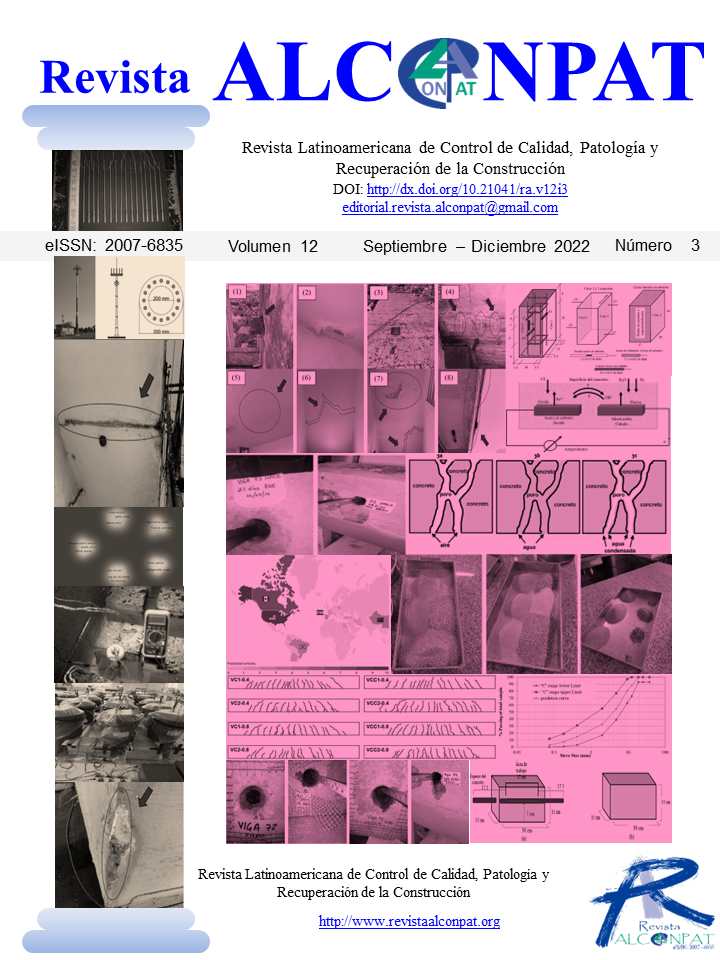Comparison between galvanic sensors (steel/stainless steel) and half cell potentials (Ecorr) for monitoring the corrosion risk of steel reinforcement in concrete structures
DOI:
https://doi.org/10.21041/ra.v12i3.620Keywords:
corrosion rate, reinforced concrete, corrosion potential, microcell, galvanic sensorAbstract
The corrosion risk of steel in concrete was assessed using internal galvanic carbon/stainless steel sensors and the external Cu/CuSO4 electrode. The sensors were used to monitor the macrocell potentials and currents of reinforced concrete prismatic specimens, with water to cement ratios of 0.4 and 0.6, immersed in 5% NaCl solution, for 18 months. The results of the potentials showed a good correlation between the two reference electrodes, being able to evaluate the corrosion of the system. In addition, the electrochemical noise technique supports observations of the effect of chloride ions. Therefore, galvanic sensors can be considered for implementation in the monitoring and evaluation of corrosion risk of reinforced concrete structures.
Downloads
References
AISI. (1983), AISI – SAE Standard carbon steels. Steel products manual, American Iron and Steel Institute.
Alonso, C., Andrade, C., Castellote, M., Castro, P. (2001), Reply to the discussion by T.U. Mohammed and H. Hamada of the paper: Chloride threshold values to depassivate reinforcing bars embedded in a standardized OPC mortar. Cement and Concrete Research. 31(5):39-840. DOI: https://doi.org/10.1016/s0008-8846(01)00486-0
Alonso, C., Andrade, C., García, A. M. (1990), Oxygen availability in the corrosion of reinforcements. Advances in Cement Research. 3(11):127-132.
DOI: https://doi.org/10.1680/adcr.1990.3.11.127
Alonso, C., Andrade, C., Nóvoa, X. R., Izquierdo, M., Pérez, M. C. (1998), Effect of protective oxide scales in the macrogalvanic behaviour of concrete reinforcements. Corrosion Science. 40(8):1379–1389. DOI: https://doi.org/10.1016/S0010-938X(98)00040-7
American Concrete Institute (2002), ACI 211.1: Recomended practice for selecting proportions for normal weight concrete, p. 953. Retrieved from https://doi.org/10.14359/7325
Arya, C., Vassie, O. (1995), Influence of cathode-to-anode area ratio and separation distance on galvanic corrosion currents of steel in concrete containing chlorides. Cement and Concrete Research. 25(5):989-998. DOI: https://doi.org/10.1016/0008-8846(95)00094-s
ASTM International. (2010). ASTM D 1411-04 Standard Test Methods for Water-Soluble Chlorides Present as Admixtures in Graded Aggregate Road Mixes. Retrieved from https://doi.org/10.1520/d1411-04
ASTM International. (2016). ASTM C 876-15 Standard Test Method for Corrosion Potentials of Uncoated Reinforcing Steel in Concrete. Retrieved from https://doi.org/10.1520/c0876
ASTM International. (2017). ASTM C 39-17 Standard Test Method for Compressive Strength of Cylindrical Concrete Specimens. Retrieved from https://doi.org/10.1520/c0039_c0039m-05e02
Dawson, J. L. (1996). Electrochemical noise measurement. In: Kearns, J. R., Scull J. R. “Electrochemical noise measurement for corrosion applications”, ASTM STP 1277. Annual Book of ASTM Standards, Philadelphia, p. 3. DOI: https://doi.org/10.1520/stp37949s
Elsener, B. (2002). Macrocell corrosion of steel in concrete-implications for corrosion monitoring. Cement and Concrete Composites. 24(1):65-72. DOI: https://doi.org/10.1016/s0958-9465(01)00027-0
Hudok, D. (1990). Properties and selection: irons, steels, and high-performance alloys. In: “Metals handbook”, 1, E.U., pp. 200-211.
Kelly R.G., Inman, M.E., Hudson, J.L. (1996), Analysis of Electrochemical Noise for Type 410 Stainless Steel in Chloride Solutions. In: Kearns, J. R., Scully, J. R. “Electrochemical noise measurement for corrosion applications”. Annual Book of ASTM Standards, Philadelphia, pp. 101-113. DOI: https://doi.org/10.1520/stp37954s
Legat, A., Dolecek, V. (1995), Corrosion Monitoring System Based on Measurement and Analysis of Electrochemical Noise. Corrosión Science. 51(4): 295-300. DOI: https://doi.org/10.5006/1.3293594
Llorens, M., Serrano, Á., Valcuende, M. (2019), Sensors for Determining the Durability of Reinforced Concrete Constructions. Revista Ingeniería de Construcción. 34(1): 81-98.
DOI: https://doi.org/10.4067/s0718-50732019000100081
McCarter, W. J., Chrisp, T. M., Butler, A., Basheer, P. A. M. (2001), Near-Surface Sensors for Condition Monitoring of Cover-Zone Concrete. Construction and Building Materials. 15(2-3): 115-124. DOI: https://doi.org/10.1016/s0950-0618(00)00060-x
McCarter, W. J., Vennesland, Ø. (2004), Sensor systems for use in reinforced concrete structures. Construction and Building Materials. 18(6):51-358.
DOI: https://doi.org/10.1016/j.conbuildmat.2004.03.008
Mohammed, T. U., Hamada, H. (2001), A discussion of the paper: Chloride threshold values to depassivate reinforcing bars embedded in a standardized OPC mortar by C. Alonso, C. Andrade, M. Castellote, and P. Castro. Cement and Concrete Research. 31(5): 835-838.
DOI: https://doi.org/10.1016/s0008-8846(01)00485-9
NMX C155. (2014). Industria de la construcción – Concreto hidráulico – Dosificado en masa – Especificaciones y métodos de ensayo. Ciudad de México: ONNCCE.
NMX C159. (2004). Industria de la construcción -Concreto -Elaboración y curado de especímenes en el laboratorio. Ciudad de México: ONNCCE.
NMX C414. (2004). Industria de la construcción -Cementos hidráulicos -Especificaciones y métodos de prueba. Ciudad de México: ONNCCE
PROCEDIMIENTO LAQ03. (2005), Determinación del contenido de Al, C, Co, Cr, Cu, Mn, Mo, Ni, P, Pb, S, Si, Ti y Zn, de aceros al carbono y aceros inoxidables por ICP-AAE y CHNS-O. CIMAV-EMA, BAJO NORMA ISO/IEC-17025-2005, México.
Raupach, M. (1996), Chloride-induced macrocell corrosion of steel in concrete-theoretical background and practical consequences. Construction and Building Materials. 10(5): 329-338.
DOI: https://doi.org/10.1016/0950-0618(95)00018-6
Raupach, M., Dauberschmidt, C. (2003), “Durability of marine structures made of high-performance concrete”. In: RILEM Proceedings, PRO 32 International Conference on Advances in Concrete and Structures, 2, pp. 919-930. ISBN: 2-912143-41-1. e-ISBN: 2351580176
Raupach, M., Schießl, P. (2001), Macrocell sensor systems for monitoring of the corrosion risk of the reinforcement in concrete structures. NDT & E International. 34(6):435-442.
DOI: https://doi.org/10.1016/s0963-8695(01)00011-1
Schiessl, P., Raupach, M. (1992), Monitoring system for the corrosion risk of steel in concrete structures. Concrete International. 14(7):52-55.
Zinc-Taek, P., Yoon-Seok, C., Jung-Gu, K., Lun, C. (2005), Development of a galvanic sensor system for detecting the corrosion damage of steel embedded in concrete structure. Cement and Concrete Research. 35(9): 1814-1819. DOI: https://doi.org/10.1016/j.cemconres.2003.11.027
Downloads
Published
How to Cite
Issue
Section
License
_______________________________
License in effect from September 2020
You are free to:
- Share — copy and redistribute the material in any medium or format for any purpose, even commercially.
- Adapt — remix, transform, and build upon the material for any purpose, even commercially.
- The licensor cannot revoke these freedoms as long as you follow the license terms.
Under the following terms:
- Attribution — You must give appropriate credit , provide a link to the license, and indicate if changes were made . You may do so in any reasonable manner, but not in any way that suggests the licensor endorses you or your use.
- No additional restrictions — You may not apply legal terms or technological measures that legally restrict others from doing anything the license permits.
Notices:
You do not have to comply with the license for elements of the material in the public domain or where your use is permitted by an applicable exception or limitation .
No warranties are given. The license may not give you all of the permissions necessary for your intended use. For example, other rights such as publicity, privacy, or moral rights may limit how you use the material.





















.png)














